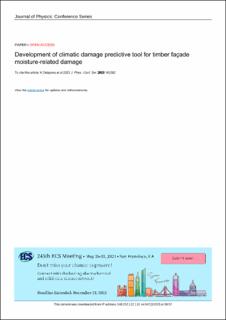Development of climatic damage predictive tool for timber facade moisture-related damage
Ostapska-Luczkowska, Katarzyna; Coelho, Guilherme Barreto Arez; Brozovsky, Johannes Georg; Kraniotis, Dimitrios; Loli, Arian
Peer reviewed, Journal article
Published version

Permanent lenke
https://hdl.handle.net/11250/3106762Utgivelsesdato
2023Metadata
Vis full innførselSamlinger
- Publikasjoner fra CRIStin - SINTEF AS [5801]
- SINTEF Community [2247]
Originalversjon
10.1088/1742-6596/2600/16/162002Sammendrag
Development of the method for automated and adaptive assessment of mould growth in the timber frame facade is presented. A heat, air, and moisture (HAM) transport simulation using the open-source Python library HAMOPY is validated against a wellestablished software (WUFI Pro 1D). Climate input of the reference year in Norway, Oslo is used in validation. The material parameters of the 1D numerical model that influence mold growth conditions most are identified via a parametric study. The increased water vapor permeability and thermal conductivity of the outside envelope as well as the critical relative humidity threshold are selected as the model updating parameters to account for the risk of the thermal bridge, moisture leakage, and mold growth conditions variation in the model. The example of the automated parametric computation of the mold growth conditions in the facade is presented for a reference climate based on the developed and validated HAM model.
